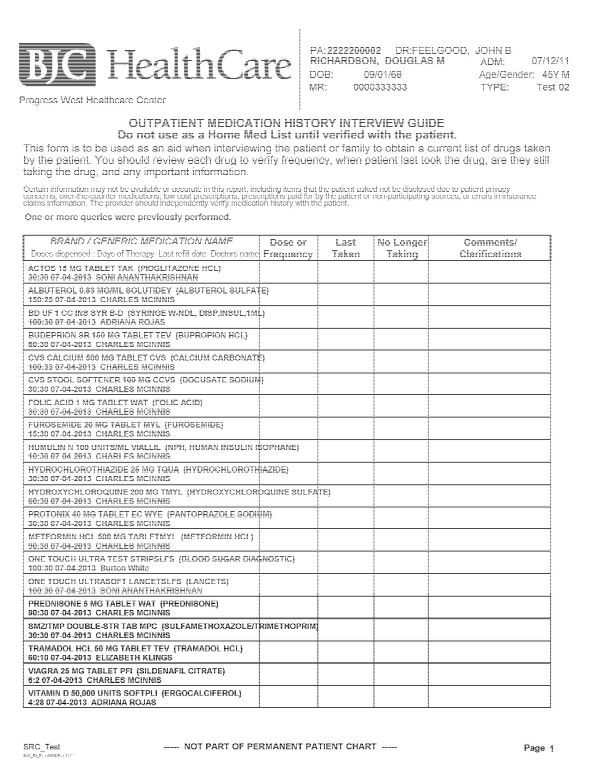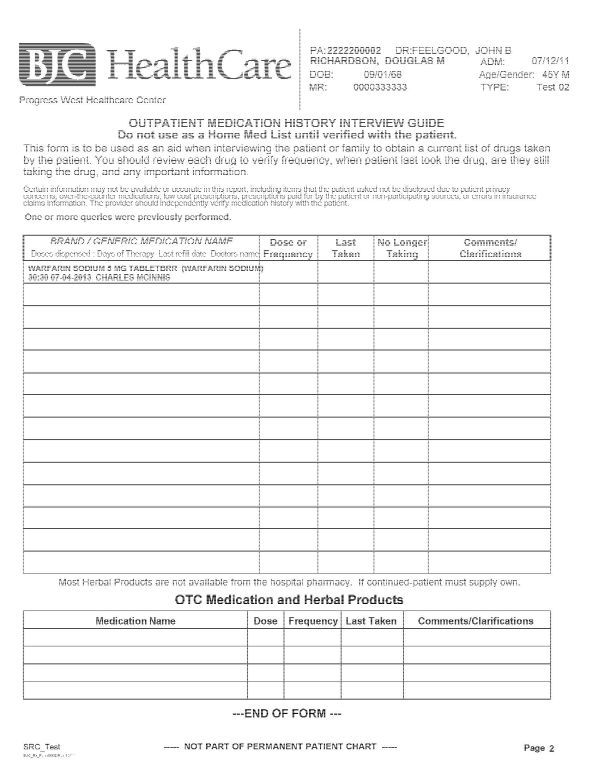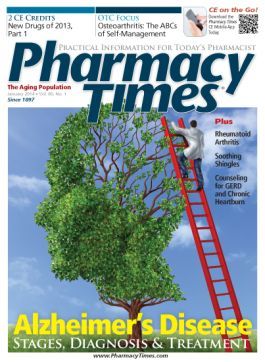Publication
Article
Pharmacy Times
Improving Medication Verification Through Technology and Pharmacist Collaboration
Author(s):
Medication errors—particularly those that result in adverse drug events (ADEs)—are more likely to occur when they involve orders placed at the time of a patient’s hospital admission, transfer, or discharge. According to the Institute of Healthcare Improvement (IHI), “Studies show that inconsistent knowledge and record keeping about medications directly threaten patient safety, causing up to 50% of all medication errors in the hospital and up to 20% of adverse drug events.”1
In response, many facilities have implemented some form of medication reconciliation procedure. IHI defines medication reconciliation as a 3-step process that includes:
- verification — collecting an accurate medication history;
- clarification — ensuring medications and doses are appropriate; and
- reconciliation — documenting all medication changes and making sure they work in harmony with the rest of the patient’s medication information.
Medication reconciliation is now a standard of care in all hospitals. The implementation of formal processes to document current medications and to communicate the patient’s complete list of medications during transitions of care has been an expectation of the Joint Commission since 2005. In 2014, medication reconciliation will mark its tenth year as a National Patient Safety Goal. Yet taking the first step—verification—is often difficult because of incomplete, inaccurate medication histories.
Enhancing medication verification
Omissions tend to be the most common problem encountered when trying to collect accurate medication histories during admission. For example, many patients have difficulty remembering all of the medications they use, including products such as eye drops, ear drops, and OTC medications. Many patients even forget to mention medications they take routinely, such as insulin, inhaled medications, and nebulizations. Even if patients remember the drugs themselves, medication histories often are missing information about dose, frequency, or the time of the last dose. Well-kept medication lists alleviate several problems of omission, but are often not updated to include medications that patients are taking temporarily, such as antibiotics.
BJC HealthCare, a large non-profit healthcare organization based in St. Louis, makes a significant effort to help patients keep medication lists, allergies, and other relevant medical information up-to-date by teaching them how to use an online portal. However, this is just part of a broader effort to enhance medication verification.
Given the importance of medication verification, BJC HealthCare also has implemented an automated process to capture prescription histories directly from outpatient pharmacy data. At all 8 of its community hospitals and both of its academic hospitals, the process is standardized: After obtaining patient consent, the verification system taps into retail pharmacy databases to provide a snapshot of all medications acquired by a patient through insurance.
While this insurance transaction data is extremely valuable from a clinical perspective, and will soon be upgraded to include patient administration instructions (ie, sig data), it is still essential to conduct a patient interview. After all, some prescriptions are not captured in the pharmacy database. These include samples, Medicaid-reimbursed medications (in some states), TRICARE-reimbursed medications, $4 medications, OTC medications, and other medications obtained through cash transactions. In addition, some pharmacies have opted out of sending transaction data to the database. These are just a few reasons why it remains critical for pharmacists and pharmacy technicians to take part in the medication verification and clarification process to ensure that the best possible medication history is obtained.
Along with the medication history data, BJC HealthCare’s automated process offers a customizable “patient interview guide” to help make these interviews as fruitful as possible. The report can be sent automatically to any printer upon patient registration. However, because BJC HealthCare is moving away from paper, all Rx History Capture reports are now sent to the patient’s electronic health record so that they may be accessed at the patient’s bedside. This provides yet another way to help pharmacists and nurses increase their efficiency and improve patient safety.
Best practices for enhancing patient safety
With each transition of care, Varkey et. al. revealed that errors may compound from admission to discharge.2 As a result, obtaining the most accurate medication history at the time of admission has a favorable downstream impact on patient safety. This factor underscores the importance of embedding pharmacists as much as possible into a computer-assisted medication verification process.
Because pharmacists possess clinical knowledge uniquely suited to medication verification and clarification, a clinical pharmacist should conduct all medication verification interviews at admission, review all reconciliations during transfers, and be available to patients across the entire continuum of hospital care. Furthermore, pharmacists should be the ones to conduct medication counseling prior to discharge to help patients understand details such as: which new medications they have to start taking; how to take their new medications; and which old medications to continue or discard.
By offering personalized patient education and a thorough review, pharmacists can help improve patients’ post-discharge medication compliance—potentially a key factor in reducing hospital readmissions. Thus, clinical pharmacists have a critical role to play in every stage of a patient’s hospital stay, transition to home, and outpatient preventive care.
In the real world, budget constraints often prevent full pharmacist involvement in medication verification; often the process is conducted by nurses or pharmacy technicians. While hospital administrators may object to paying a pharmacist to perform medication verification and to be involved in all stages of the medication reconciliation process, it’s imperative to weigh the cost of the pharmacist against the potential costs of ADEs and decreased reimbursement due to readmissions—not to mention the cost of patient harm due to ADEs.
In the meantime, the importance of supplemental technology and standardized processes continues to grow. Providing automated medication history capture can help ensure that nurses, pharmacy techs, and even pharmacists are well prepared for a consistent, effective verification procedure. In the context of the budgetary pressures all hospitals are facing today, automating the medication verification process is an important step toward increasing efficiency and lowering costs while increasing patient safety and improving outcomes.
About the Author
Bradley L. McNew, PharmD, is a clinical pharmacist in the Performance Improvement division of the Clinical Workflow Improvement Department at the BJC Learning Institute in St. Louis, MO. He can be reached at [email protected].
Technology Overview
BJC HealthCare uses the Rx History Capture Solution — a module of SMARTworks® Clinical Enterprise — that helps healthcare organizations enhance the medication verification process. Both solutions are offered by Standard Register Healthcare, Dayton, OH.
References
- Accuracy at Every Step: The Challenge of Medication Reconciliation, Institute for Healthcare Improvement website. Accessed November 25, 2013 http://www.ihi.org/knowledge/Pages/ImprovementStories/AccuracyatEveryStep.aspx
- Varkey P, Cunningham J, O‘Meara J, et al. Multidisciplinary approach to medication reconciliation in an academic setting. Am J Health-System Pharm. 2007;64:850-854.
Figure 1. Medication History Interview Guide automatically populated with patient’s medication list supplied by the Rx History Capture Solution (Courtesy of BJC HealthCare)



Newsletter
Stay informed on drug updates, treatment guidelines, and pharmacy practice trends—subscribe to Pharmacy Times for weekly clinical insights.






